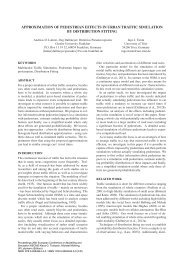Pedestrian Simulation for Urban Traffic Scenarios
Pedestrian Simulation for Urban Traffic Scenarios
Pedestrian Simulation for Urban Traffic Scenarios
Create successful ePaper yourself
Turn your PDF publications into a flip-book with our unique Google optimized e-Paper software.
1224m MAINS<br />
²<br />
Multimodal<br />
Innercity<br />
<strong>Simulation</strong><br />
IM<br />
Multimodale Innerstädtische Straßenverkehrssimulation<br />
Figure 5. Map extract of the city Hanau, Germany with an accumulated length of roads of 548km, amount of EIs: 5,400 and<br />
amount of NIs: 3,878.<br />
Figure 8. Change of aggressiveness over time.<br />
a basic AF of about +0.4, leading to a behavior which is overcautious.<br />
From point a to c, the pedestrian has to wait <strong>for</strong> a<br />
sufficient gap in order to cross a road. His aggressiveness increases<br />
with step size 0.1 · s −1 . This value is not documented<br />
in literature but shows the basic principle. Finally, the crossing<br />
action takes place and the aggressiveness recovers.<br />
5.3 <strong>Pedestrian</strong> Crossings<br />
<strong>Pedestrian</strong> crossings can be analyzed with help of the well<br />
known density (ρ) - mean velocity (v) diagram. The traffic<br />
density of a pedestrian way is calculated as stated in equation<br />
9.<br />
ρ = #pedestrians<br />
C<br />
(9)<br />
The capacity of a pedestrian way is C = w·l ·(0.457) −1 . This<br />
definition is according to [1] which defines cells with width<br />
of 0.457m being fully occupied by one pedestrian.<br />
The ρ - v relation has to be divided according to the amount<br />
of pedestrians walking in both directions, because different<br />
compositions lead to different ρ - v relations.<br />
In order to analyze the relation, a single pedestrian way<br />
object is used <strong>for</strong> simulation. It has five lanes and a length of<br />
l = 10 · 0.457m and thus leads to a realistic pedestrian crossing.<br />
The amount of pedestrians is set to one <strong>for</strong> the first run<br />
and is then increased by 1, until 75 runs have been made.<br />
The results represent average values of 10 replications <strong>for</strong><br />
each setting. After a settlement phase of 500 iterations, 5,000<br />
iterations are used <strong>for</strong> measurements of the average velocity<br />
v of all pedestrians on the way. This procedure is per<strong>for</strong>med<br />
<strong>for</strong> different compositions of directions of travel with<br />
50%,60%,··· ,100% pedestrians walking into one direction<br />
and the rest into the other direction. Figure 9 shows the resulting<br />
diagram.<br />
As can be seen, the maximum density differs in relation to<br />
the composition of walking directions. This results from the<br />
queuing process of the algorithm, shown in figure 4. <strong>Pedestrian</strong>s<br />
walk faster, when there is no opposing traffic and there<strong>for</strong>e<br />
the distances between two subsequent pedestrians increase.<br />
Figure 9 shows that the more balanced the distribution of<br />
walking directions is, the higher the maximum values of ρ<br />
get and the lower the mean velocity v. This is in line with the<br />
results presented in [1] with the difference that only realistic<br />
densities <strong>for</strong> urban traffic road crossings are generated.<br />
It seems to be likely that only parts of the shown figure 9<br />
occur in urban traffic. Hence, another experiment comes back



